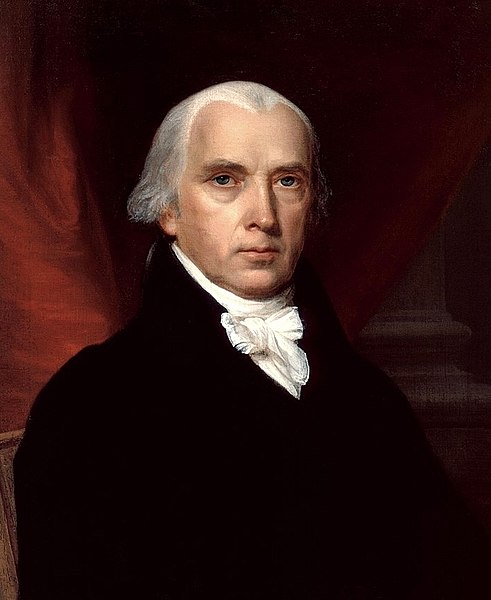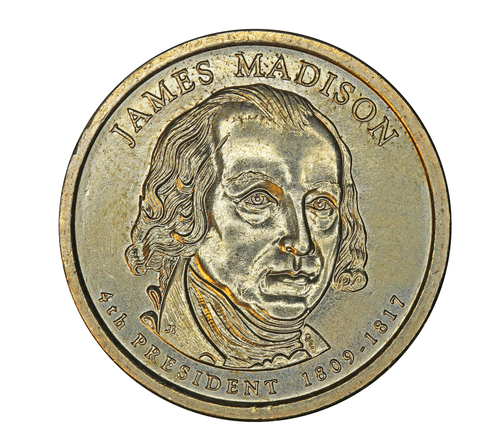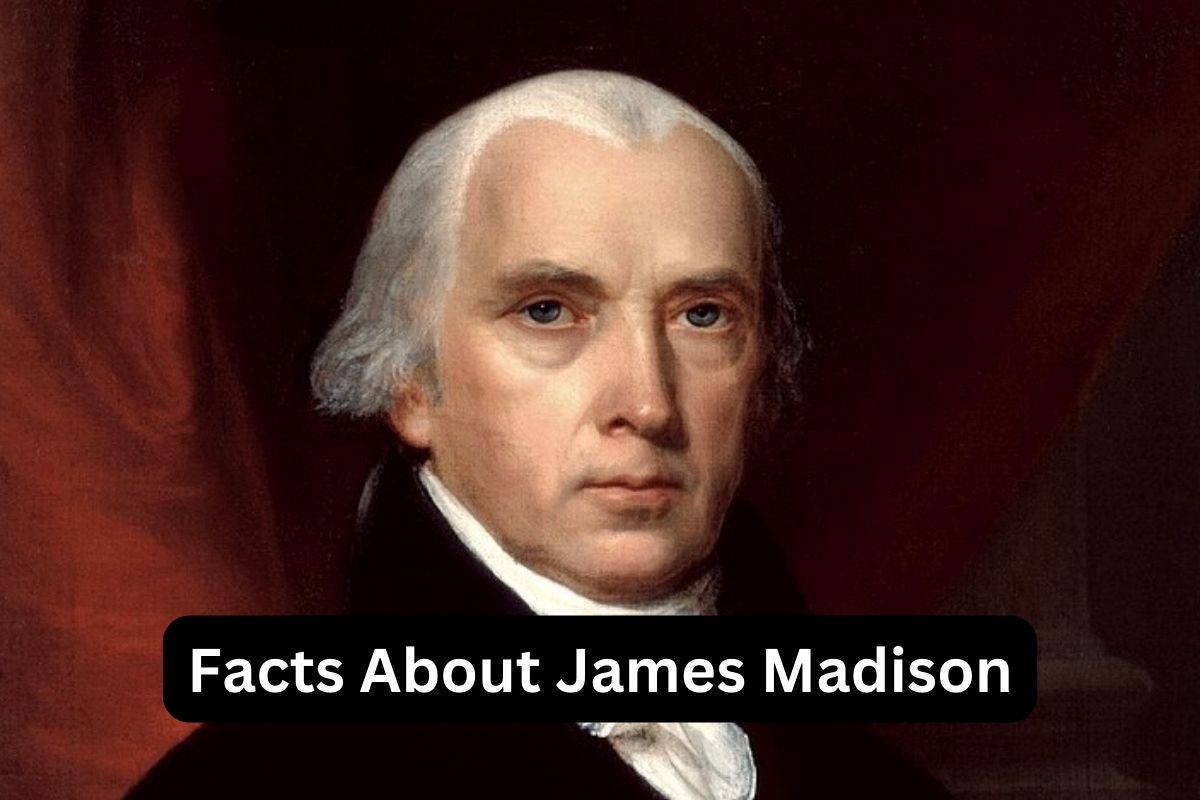James Madison (1751-1836) was an American statesman and political theorist who played a pivotal role in the founding of the United States. As the fourth president of the United States, serving from 1809 to 1817, he left an indelible mark on American history.
Widely recognized as the “Father of the Constitution,” Madison’s intellect and political acumen shaped the framework of the U.S. government and the protection of individual liberties.
His contributions include drafting the United States Constitution, advocating for the Bill of Rights, and playing a crucial role in the formation of the Democratic-Republican Party.
Madison’s presidency was marked by the War of 1812, and he is remembered for his efforts to defend American sovereignty and expand the country’s territorial boundaries.
Despite his small physical stature, Madison’s influence and legacy as a founding father and champion of democracy endure to this day.
James Madison Facts
1. James Madison was born on March 16, 1751, in Port Conway, Virginia
James Madison was born on March 16, 1751, in Port Conway, Virginia. He was the oldest of 12 children born to James Madison Sr. and Nelly Conway Madison. His father was a wealthy tobacco planter, and his mother came from a prominent Virginia family.
Also Read: James Madison Accomplishments
Madison grew up on his family’s plantation called Montpelier, where he developed a deep appreciation for the land and agriculture.

2. He was the fourth president of the United States, serving from 1809 to 1817
Madison is widely regarded as one of the most important figures in American political history. He played a pivotal role in the creation of the United States Constitution, which established the framework for the American government that is still in place today.
He was instrumental in shaping the structure of the federal government, advocating for a strong central government while also protecting individual liberties.
3. Madison was one of the primary authors of the United States Constitution
As one of the primary authors of the United States Constitution, Madison’s contributions were significant. He arrived at the Constitutional Convention in 1787 well-prepared with extensive knowledge of political theory and a vision for a balanced government.
Throughout the convention, he actively participated in the debates, consistently promoting the idea of a stronger central government to replace the weak Articles of Confederation.
4. He played a crucial role in the drafting and promotion of the Bill of Rights, which are the first ten amendments to the U.S. Constitution
James Madison played a crucial role in the drafting and promotion of the Bill of Rights, which are the first ten amendments to the United States Constitution.
Although Madison initially believed that a Bill of Rights was unnecessary, he came to recognize its importance in protecting individual liberties.
As a member of the House of Representatives, he introduced a set of amendments to the Constitution, drawing from state declarations of rights.
These amendments, which were eventually ratified in 1791, outlined fundamental freedoms such as freedom of speech, religion, and the right to a fair trial.

5. Madison served as Secretary of State under President Thomas Jefferson from 1801 to 1809
Madison served as the Secretary of State under President Thomas Jefferson from 1801 to 1809. During his tenure, he played a vital role in expanding the territory of the United States through the Louisiana Purchase of 1803.
This acquisition from France doubled the size of the country and opened up vast lands for future settlement and economic growth. As Secretary of State, Madison also dealt with foreign policy issues, including the escalating tensions between Britain and France during the Napoleonic Wars.
6. He was a key advocate for a strong federal government
Madison was one of the founding members of the Democratic-Republican Party, which he helped establish alongside Thomas Jefferson. The party stood in opposition to the Federalist Party and favored limited government, agrarianism, and strict interpretation of the Constitution.
Madison’s political ideology aligned with the Democratic-Republicans, and he became a key advocate for a strong federal government that protected individual rights while also promoting the interests of agricultural states.
7. Madison’s presidency was marked by the War of 1812
Madison’s presidency, from 1809 to 1817, was marked by the War of 1812. The conflict arose primarily due to British maritime practices that infringed upon American sovereignty and the impressment of American sailors into the British navy.
Also Read: Facts About the War of 1812
Despite initial military setbacks, Madison’s administration successfully rallied public support for the war, framing it as a struggle for national honor and territorial integrity.
The conflict saw significant battles, such as the Battle of New Orleans, where American forces, led by General Andrew Jackson, achieved a decisive victory.
Also Read: The Battle of New Orleans Facts
The War of 1812 ultimately ended in a stalemate but solidified American independence and bolstered national pride. Additionally, during Madison’s presidency, the British army infamously burned down the White House and other government buildings in Washington, D.C., in 1814.
This event, known as the Burning of Washington, highlighted the vulnerability of the young nation’s capital but also served as a symbol of American resilience and determination.
8. During the war, the British burned down the White House and other government buildings in Washington, D.C.
Madison’s presidency faced a significant setback during the War of 1812 when British forces invaded Washington, D.C., and burned down important government buildings, including the White House and the Capitol.
The attack, which occurred in August 1814, was a response to American military actions in Canada. The destruction of the capital was a humiliating event for the young nation, and Madison had to temporarily relocate the government to different locations until the city could be rebuilt.
9. Madison was the shortest president in U.S. history, standing at around 5 feet 4 inches (163 cm) tall
James Madison holds the distinction of being the shortest president in U.S. history, standing at approximately 5 feet 4 inches (163 cm) tall. He was often described as small and thin, with a slender frame.
Despite his physical stature, Madison possessed a keen intellect and was highly respected for his intelligence and political acumen.
10. He married Dolley Payne Todd in 1794, and she became one of the most popular first ladies in American history
Madison married Dolley Payne Todd on September 15, 1794. Dolley, a vivacious and socially adept woman, brought energy and charm to Madison’s political career. She was known for her hospitality and played a significant role as a hostess during Madison’s presidency.
Dolley Madison is particularly remembered for her efforts to save important historical artifacts, including a portrait of George Washington, before the British invaded Washington, D.C., during the War of 1812.
11. Madison retired from public life after his presidency and spent his later years at his estate called Montpelier in Virginia
After Madison’s presidency ended in 1817, he retired from public life and returned to his plantation, Montpelier, in Virginia. Despite his intention to lead a quiet life, Madison continued to be sought out for his political insights and advice.
He also played an active role in the founding of the University of Virginia, serving as the university’s rector from 1826 until his death.
12. In 1826, Madison served as a delegate to the Virginia Constitutional Convention and played a role in revising the state’s constitution
In 1826, Madison was selected as a delegate to the Virginia Constitutional Convention. He contributed significantly to the revision of Virginia’s state constitution, advocating for a separation of powers, religious freedom, and a greater emphasis on popular representation.
Madison’s expertise and reputation as a founding father brought considerable influence to the convention’s proceedings.
13. James Madison died on June 28, 1836, at the age of 85, making him the last surviving signer of the U.S. Constitution
James Madison passed away on June 28, 1836, at the age of 85. He died at Montpelier, surrounded by family and friends. His death marked the end of an era, as Madison was the last surviving signer of the U.S. Constitution.
His contributions to the nation’s founding and his intellectual legacy continued to be celebrated and honored long after his passing. Madison’s influence on American democracy and constitutional law remains significant, and he is remembered as one of the key figures in shaping the early republic.
